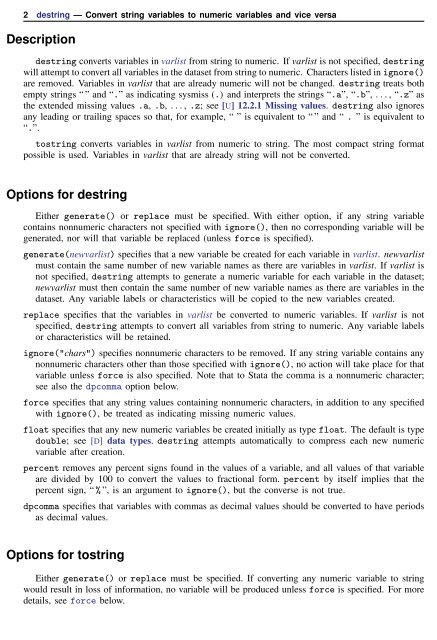destring - Stata
destring - Stata
destring - Stata
You also want an ePaper? Increase the reach of your titles
YUMPU automatically turns print PDFs into web optimized ePapers that Google loves.
2 <strong>destring</strong> — Convert string variables to numeric variables and vice versa<br />
Description<br />
<strong>destring</strong> converts variables in varlist from string to numeric. If varlist is not specified, <strong>destring</strong><br />
will attempt to convert all variables in the dataset from string to numeric. Characters listed in ignore()<br />
are removed. Variables in varlist that are already numeric will not be changed. <strong>destring</strong> treats both<br />
empty strings “ ” and “.” as indicating sysmiss (.) and interprets the strings “.a”, “.b”, . . . , “.z” as<br />
the extended missing values .a, .b, . . . , .z; see [U] 12.2.1 Missing values. <strong>destring</strong> also ignores<br />
any leading or trailing spaces so that, for example, “ ” is equivalent to “ ” and “ . ” is equivalent to<br />
“.”.<br />
tostring converts variables in varlist from numeric to string. The most compact string format<br />
possible is used. Variables in varlist that are already string will not be converted.<br />
Options for <strong>destring</strong><br />
Either generate() or replace must be specified. With either option, if any string variable<br />
contains nonnumeric characters not specified with ignore(), then no corresponding variable will be<br />
generated, nor will that variable be replaced (unless force is specified).<br />
generate(newvarlist) specifies that a new variable be created for each variable in varlist. newvarlist<br />
must contain the same number of new variable names as there are variables in varlist. If varlist is<br />
not specified, <strong>destring</strong> attempts to generate a numeric variable for each variable in the dataset;<br />
newvarlist must then contain the same number of new variable names as there are variables in the<br />
dataset. Any variable labels or characteristics will be copied to the new variables created.<br />
replace specifies that the variables in varlist be converted to numeric variables. If varlist is not<br />
specified, <strong>destring</strong> attempts to convert all variables from string to numeric. Any variable labels<br />
or characteristics will be retained.<br />
ignore("chars") specifies nonnumeric characters to be removed. If any string variable contains any<br />
nonnumeric characters other than those specified with ignore(), no action will take place for that<br />
variable unless force is also specified. Note that to <strong>Stata</strong> the comma is a nonnumeric character;<br />
see also the dpcomma option below.<br />
force specifies that any string values containing nonnumeric characters, in addition to any specified<br />
with ignore(), be treated as indicating missing numeric values.<br />
float specifies that any new numeric variables be created initially as type float. The default is type<br />
double; see [D] data types. <strong>destring</strong> attempts automatically to compress each new numeric<br />
variable after creation.<br />
percent removes any percent signs found in the values of a variable, and all values of that variable<br />
are divided by 100 to convert the values to fractional form. percent by itself implies that the<br />
percent sign, “ % ”, is an argument to ignore(), but the converse is not true.<br />
dpcomma specifies that variables with commas as decimal values should be converted to have periods<br />
as decimal values.<br />
Options for tostring<br />
Either generate() or replace must be specified. If converting any numeric variable to string<br />
would result in loss of information, no variable will be produced unless force is specified. For more<br />
details, see force below.
















